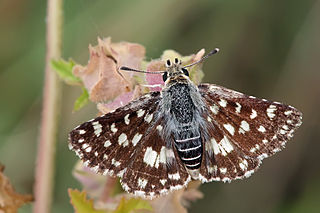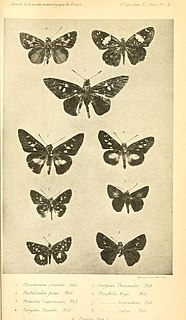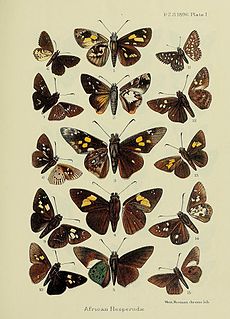
Tzaneen is a large tropical garden town situated in the Mopani District Municipality of the Limpopo province in South Africa. It is situated in a high rainfall fertile region with tropical and subtropical agriculture taking place in a 20,000 km2 region. It is Limpopo's second largest town after Polokwane.

Spialia is a genus of skippers in the family Hesperiidae, which are mainly found in Africa and Asia. They are commonly called grizzled skippers or sandmen.
Dingana clara, the Wolkberg widow, is a butterfly of the family Nymphalidae. It is only known from the Wolkberg in the Limpopo Province.
Coenyra rufiplaga, the Secucuni shadefly, is a butterfly of the family Nymphalidae. It is found in South Africa, it is widespread in Limpopo from the Waterberg Biosphere and Strydpoortberg to the Wolkberg.
Pseudonympha loxophthalma, the big-eye brown, is a butterfly of the family Nymphalidae. It is found in South Africa, the Strydpoortberg, Wolkberg and Waterberg in Limpopo.
Spialia nanus, the dwarf sandman, is a butterfly of the family Hesperiidae. It is found in South Africa, in the western Cape, western Free State, southern North West Province and the northern Cape.
Spialia delagoae, the Delagoa sandman or Delagoa grizzled skipper, is a butterfly of the family Hesperiidae. It is found in Namibia, Botswana, Transvaal, Swaziland, Zululand, Zimbabwe, Mozambique and Kenya. The habitat consists of moist and dry savanna.
Spialia sataspes, the Boland sandman, is a butterfly of the family Hesperiidae. It is found in South Africa, in fynbos in the western Cape and along the mountain chains of the northern Cape and along the coast to Port Elizabeth in the eastern Cape and inland to Bedford and Grahamstown.
Spialia depauperata, the wandering sandman or deprived grizzled skipper, is a butterfly of the family Hesperiidae. It is found from Kenya to Natal and in Uganda.
Spialia asterodia, the star sandman or Asterodia sandman, is a butterfly of the family Hesperiidae. It is found in South Africa from the western Cape to the southern part of the north Cape and across the east Cape to Lesotho, the Free State, Swaziland, western KwaZulu-Natal, Mpumalanga, the Limpopo Province, the eastern North West Province and Gauteng. It is also present in southern Mozambique and Zimbabwe. The habitat consists of grassland and grassy areas in fynbos, Karoo and Bushveld.
Spialia agylla, the grassveld sandman, is a butterfly of the family Hesperiidae. It is found in South Africa.
Spialia dromus, the forest sandman, dromus grizzled skipper or large grizzled skipper, is a butterfly of the family Hesperiidae. It is found in tropical Africa. In South Africa it is found along the eastern Cape coast to KwaZulu-Natal into Swaziland. It is also present in Mpumalanga and the Limpopo Province into northern Gauteng and the extreme north-west of the North West Province.

Spialia diomus, the common sandman or Diomus grizzled skipper, is a butterfly of the family Hesperiidae. It is found in tropical Africa and south-western Arabia.

Spialia spio, the mountain sandman or Spio grizzled skipper, is a butterfly of the family Hesperiidae. It is found in tropical Africa and south-western Arabia. In South Africa it is found all over the eastern side of the country.

Spialia colotes, the Bushveld sandman, is a butterfly of the family Hesperiidae. The species was first described by Herbert Druce in 1875. It is found in Angola, Botswana and from South Africa to Ethiopia and south-western Arabia.
Spialia confusa, the confusing sandman, is a butterfly of the family Hesperiidae. It is found in south-eastern Africa, from Zululand, Zimbabwe and Mozambique to Kenya.

Spialia mafa, the Mafa grizzled skipper or Mafa sandman, is a butterfly of the family Hesperiidae. It is found in south-western Africa, in KwaZulu-Natal, Botswana, Zimbabwe and from the Cape in South Africa to Sudan and southern Arabia.
Spialia paula, the mite sandman, is a butterfly of the family Hesperiidae. It is found in Botswana, Transvaal and Zimbabwe. The habitat consists of dry savanna.
Aloeides stevensoni, the Stevenson's copper, is a butterfly of the family Lycaenidae. It is found in South Africa, where it is restricted to montane sourveld grassland on the Wolkberg near Haenertsburg.

The Wolkberg is a mountain range in Tzaneen, Limpopo Province, South Africa. It is a northern termination and a subrange of the Drakensberg mountain range which lines up from Eastern Cape, Lesotho, Kwazulu Natal and Mpumalanga. At 2200m (7200ft) above sea level, it is the highest mountain range in Limpopo, together with the Iron crown mountain. Its Meteorological significance is that it brings along cold fronts and is a source of cold winters throughout the Limpopo province, the cold front gets transferred from greater Drakensberg mountains in Kwazulu Natal all the way to the Wolkberg. Without the Wolkberg, Limpopo will not experience cold winters at all. The range extends for about 30 km (19 mi) in a NW/SE direction north of Sekhukhuneland. The nearest towns are Haenertsburg and Tzaneen.





